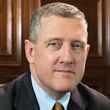President's Message: Recent Actions Increase the Fed's Transparency
At the January 2012 meeting, the Federal Open Market Committee (FOMC) took steps to further increase the Fed's transparency regarding monetary policy decisions and strategy. For one, the FOMC named an explicit, numerical inflation target. With this action, the Fed joined many other central banks—including the Bank of England, the European Central Bank and the Reserve Bank of New Zealand—in adopting an inflation target. Also in January, the FOMC released its forecasts of the target federal funds rate. Several other central banks publish forecasts of their policy rate as well.
The FOMC set an inflation target of 2 percent, as measured by the annual change in the overall personal consumption expenditures (PCE) price index. To clarify, this does not mean inflation must be 2 percent in the short term; rather, monetary policy should be set so that inflation moves toward the target over time and, in the absence of unpredictable changes in either supply or demand, would reach 2 percent in the medium term. The FOMC will target the headline inflation rate as opposed to any other measure (e.g., core inflation, which excludes food and energy prices) because it makes sense to focus on the prices that U.S. households actually have to pay.1 To illustrate, headline PCE inflation (measured from one year earlier) has been higher than core PCE inflation for more than three-fourths of the months since January 2000. This implies that the changes in prices excluded from the core measure are not simply temporary fluctuations, especially those for energy. Headline inflation is, therefore, the appropriate measure to target.
Inflation targeting emphasizes control over inflation as the key long-term goal of monetary policy. Although the FOMC did not set an employment target in addition to the inflation target, the January decision is still consistent with the Fed's dual mandate to promote maximum sustainable employment and price stability. Keeping inflation low and stable helps the market economy allocate resources optimally, which then leads to the best possible employment outcomes. This interpretation of how to pursue the dual mandate resulted, in part, from lessons of the 1970s.
During the 1960s, economists thought there was a permanent trade-off between unemployment and inflation—that is, lower unemployment would be accompanied by higher inflation and vice versa. This belief was shattered in the 1970s, when the U.S. had both high inflation and high unemployment. In addition, the real side of the economy was very volatile, and the U.S. suffered through four recessions from 1970 to 1982. From this experience, the FOMC and other policymakers around the world learned that high inflation is very damaging and does nothing to address fundamental macroeconomic issues. Afterward, the FOMC achieved low and stable inflation, and the U.S. experienced a long period of good economic performance compared with the 1970s.2
Having an inflation target helps to reduce uncertainty about future inflation rates and, thus, helps to avoid the 1970s experience. Even with an inflation target, though, the FOMC will continue to have differences of opinion among its members as to how to respond to current and expected economic conditions. For instance, a so-called hawk may place more weight on deviations of inflation from the target, whereas a so-called dove may place more weight on unemployment. As a result, their monetary policy recommendations may be different, despite both targeting the same inflation rate. One interpretation is that while the inflation target provides a nominal anchor for the economy, policymakers can debate about the appropriate way to adjust policy to move to that target.
As for the other step taken in January, the FOMC released the 17 participants' forecasts of when the federal funds rate target would first move above its current level and of the appropriate policy rate path. This "first" increase is noteworthy because the federal funds rate target has been in the 0-0.25 percent range since December 2008. While releasing these forecasts was a move toward more transparency, a better way in my view to give a basic overview and our perspective on the key economic issues would be to release a quarterly report on the economy, similar to what the Bank of England publishes.
One advantage of having a quarterly report on the economy is that it provides policymakers the opportunity to comment on many different issues and subtleties that are affecting the economy. For instance, the report could include a discussion about the foreign exchange situation, special seasonal factors, certain market disruptions and any other relevant topics. Such a report would also provide a chance for the FOMC to link its forecasts of gross domestic product growth, the unemployment rate, PCE inflation, core PCE inflation and the fed funds rate and, therefore, to tell a coherent narrative. Now, these forecasts are "disconnected": We release summaries across FOMC participants for each variable. A quarterly report would likely provide a valuable public service in the U.S. and might be something for the FOMC to strive for as we continue to seek ways to become more transparent.
References
- For more on headline vs. core inflation, see my speech on May 18, 2011, "Measuring Inflation: The Core Is Rotten." https://www.stlouisfed.org/~/media/Files/PDFs/Bullard/remarks/Measuring_Inflation_May_18_2011_FINAL.pdf [back to text]
- See also my message in the St. Louis Fed's 2010 annual report, "The Fed's Dual Mandate: Lessons of the 1970s." http://www.stlouisfed.org/annual-report/2010 [back to text]
Views expressed in Regional Economist are not necessarily those of the St. Louis Fed or Federal Reserve System.
For the latest insights from our economists and other St. Louis Fed experts, visit On the Economy and subscribe.
Email Us


